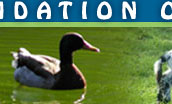Florida's Alligators
Alligators are part of what makes Florida unique. Learning to
respect and protect these animals is nothing less than essential.
Not
long ago hunting devastated Florida's alligator population until
they were given federal protection in the 1970s. Today, alligators
remain vulnerable to human exploitation. Though large in size,
alligators are not by instinct aggressive toward humans, and actually
have a natural fear of humans.
Alligators play an important role in Florida's ecosystem. They
build ponds and nests in wetlands that create habitat for a wide
variety of life. For example, the Florida Red-bellied turtle incubates
her eggs in `alligator holes,' an important source of water in
the dry season.
Alligators
have complex social behavior, including elaborate courtship displays.
The bellowing of courting alligators resonates throughout swamps
in the spring. Recent studies on alligator social behavior have
found a complexity in these animals' ability to communicate vocally
and visually (through a complex series of body postures). Baby
alligators stay with their mothers for as long as two years. Female
alligators are very protective of their nests. These unique animals
descended from crocodilians who have existed for about 150 million
years and can live to be 35 years old in the wild.
The four main
threats to alligators are human encroachment on habitat, hunting,
farming, and alligator wrestling. These are discussed below, followed
by some suggestions as to what you can do to help alligators.
Human Encroachment into Alligator Habitat
The greatest
threat to alligators today comes from human encroachment into
their habitat. Wildlife know no boundaries. When people and animals
live closely together it is usually the wildlife that suffers.
Created in 1947, the Everglades National Park was established
in part to preserve alligator (and other animals’) habitat,
but real problems continue to beset this landscape. Continuing
pressures associated with urbanization, industry and agriculture
require a constant search for additional solutions. A burgeoning
human population thirsts for the same water that animals need
to survive.
Today, 900 people move to Florida daily; 39 million people vacation
here some years; 12 million come in winter's dry season as water
supplies naturally drop. The historic Everglades -- four-fifths
lies outside the park -- feels this population pressure. Only
California, New York, and Texas today outstrip Florida in population.
Florida's daily population increase of 900 residents creates new
demands to supply 200,000 more gallons of freshwater every day.
Added square miles of building and paving reduce rainwater penetration
into aquifers, the water-bearing layers below ground that store
water that wells may tap. So human development not only directly
reduces available alligator habitat, it also strains precious
water resources they need to survive.
Hunting
During Florida's month long public alligator hunt, each hunter
is allowed to kill up to five alligators.
Alligators
are hunted in darkness on lakes and other waterways in Florida
using bright lights, bait and a variety of weapons. Harpoons,
consisting of a sharp, penetrating point attached to a restraining
line, are the most popular weapon for hunting alligators, although
a three-prong "snatch" hook used with a fishing rod,
baited wooden pegs, and bows are also common.
After being harpooned or hooked, the unfortunate alligator is
fought to exhaustion, drawn close to the boat, and killed by lowering
his/her head beneath the water and firing a bangstick. Hunters
describe how, upon firing of the bangstick, "blood colors
the water a cloudy red."
Regulations state that alligators must be killed before being
dragged into a boat, but alligators are extremely difficult to
kill. The improper placement and discharge of the bangstick frequently
just renders the alligator temporarily unconscious. Without having
the spinal cord severed and the brain destroyed, the alligator
can be left to suffer long after being pulled from the water.
Alligator
Farming
Alligators are raised for their skin and flesh on “alligator
farms" in the southern United States. The farming of alligators
began after the discovery at some of Florida's earliest roadside
zoos that alligators breed successfully in captivity. Today, in
Louisiana, Florida and other southern states, close to 200 farms
raise alligators from eggs to slaughter. In Florida, tens of thousands
of these magnificent animals are slaughtered each year.
Alligators on farms live for years in often dirty, crowded and
highly unnatural conditions in concrete or metal tanks. Disease
and fighting among alligators raised for slaughter are commonplace.
Slaughter
on an alligator farm is inhumane. The farmer decides which methods
will be used to kill the animals. They may be clubbed with hammers
or shot. Sometimes axes or sharp wedges are used to sever the
spinal cord. Although not able to move about, the alligator may
still be alive and semi-conscious when skinning begins. The bangstick,
a firearm also used in hunting alligators, was developed as a
result of many alligators at processing facilities being skinned
while still breathing, their eyes open, fully conscious.
The alligator
industry is attempting to introduce alligator products into mainstream
markets.
Alligator
Wrestling
Alligator
wrestling is among the cruelest of Florida's attractions. Alligator
wrestlers perform at roadside tourist stops or fairs across the
country. The shows are billed as "Man vs. Gator," a
contest in which the odds are stacked against the alligator. One
thing is certain: alligators are never willing participants in
the spectacle.
At the height
of the tourist season, attractions may put on as many as two dozen
shows a day. Many alligator shows frequently acquire new, "fresh"
alligators, and send to slaughter those animals who have grown
accustomed to being handled.
Alligator
wrestling acts begin when the animal is dragged by the tail into
the center of the ring. What follows next varies. Some wrestlers
jump or climb onto the alligator's back, putting pressure with
both hands on the animal’s neck, forcing his or her head
down. Others force the mouth closed with one hand, and attempt
to flip the animal. This ends with the overturned alligator losing
consciousness. Another trick is to cover the alligator's eyes
with one hand, which causes the animal to stop fighting. To conclude,
a hard rap on the nose makes the alligator open his mouth and
show the audience his teeth.
It is wrong
to hold wild animals in captivity for entertainment and profit.
Alligator shows are not educational. In Canada, alligator wrestling
promoters have been brought to court on animal cruelty charges.
Israel outlawed alligator wrestling in 1997.
WHAT
YOU CAN DO TO HELP ALLIGATORS:
· Never buy products made from alligators, and speak out
against the sale of alligator meat or skin.
· Conserve water! This helps all wildlife.
· Boycott alligator farms, like GatorLand in Orlando, which
operate as tourist attractions, with gift shops selling souvenirs
and sometimes offering alligator wrestling, and explain to your
friends and family why you’re doing so.
· Speak out against the killing of alligators for sport!
· Stay a safe distance away from alligators you see in
the wild. As with all wildlife, look but don’t touch! Don’t
risk instigating an incident that may result in the alligator
being removed and killed.
· Contact ARFF to find out when our next pro-alligator
demo is!
· Make a generous donation to ARFF to support our pro-alligator
education efforts.








